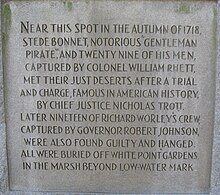Battle of Cape Fear River (1718)
| Battle of Cape Fear River | |||||||
|---|---|---|---|---|---|---|---|
| Part of the Golden Age of Piracy | |||||||
 An 18th-century map of the Cape Fear River | |||||||
| |||||||
| Belligerents | |||||||
|
|
| ||||||
| Commanders and leaders | |||||||
|
|
| ||||||
| Strength | |||||||
| 2 sloops |
3 sloops 3 canoes | ||||||
| Casualties and losses | |||||||
| 30 killed and wounded |
12 killed and wounded 41 captured 3 sloops captured 3 canoes captured | ||||||
The Battle of Cape Fear River, also known as the Battle of the Sandbars, was fought in September 1718 between two sloops from the
Background
During the end of the
In late August, reports of Bonnet's sloops in the Cape Fear River reached South Carolina governor Robert Johnson. Johnson ordered Colonel William Rhett to command an operation to destroy the pirate threat. He did not have regular Royal Navy sailors under his command, but locally raised sailors from Charleston, South Carolina. At Rhett's disposal were two eight-gun sloops with a combined complement of 130 men.
Battle

Rhett's ships reached the Cape Fear River estuary on the night of September 26, 1718, and was sighted by Bonnet and his men. Believing the sloops to be that of merchants, the pirates boarded three
Instead of fleeing up the small river in darkness, Bonnet decided that he would fight his way back to the sea, so the next morning at daylight, the pirates prepared to pass the two sloops, which were now free of the sandbar. They dispersed amongst Royal James, Fortune and Francis and loaded their arms. At daylight the following morning, Bonnet raised his
At this point, only Henry and Royal James were within range of each other. For five to six hours, the two sides dueled, each unable to move. Henry was grounded in a position which left her crew with minimal cover from incoming fire. The opposite was true for Royal James, whose hull provided a bulwark against enemy fire. During the fighting, Bonnet stayed on deck with his pistol in hand and warned that he would shoot any man who showed cowardice. The pirates' morale was good though; they cheered each other on and dared the South Carolinians to board. After five hours of fighting the South Carolinians had suffered 30 casualties, with nine pirates also killed or injured.[1]
The sloops were downstream, and when the water began to rise in the early afternoon, they were freed, while Bonnet's ships remained stranded. Rhett's ships repaired their rigging and raised their sails. Soon after, Henry was in a position to fire its starboard guns directly onto the deck of Bonnet's Royal James.
Aftermath
The South Carolinians suffered twelve killed and eighteen wounded, while the pirates sustained twelve casualties and all the survivors were captured.
References
- ^ ISBN 9780471758853.
- ^ "Other Early Herriotts in America" (PDF). Herriottheritage.org. Retrieved 10 March 2016.
Further reading
- Cordingly, David. Under the Black Flag: The Romance and Reality of Life Among the Pirates New York: Random House, (1996) ISBN 0-679-42560-8.
- The Tryals of Major Stede Bonnet, and Other Pirates. London, Printed for Benj Cowse at the Rose and Crown in St Paul's Church-Yard, (1719)
- Woodard, Colin. The Republic of Pirates. New York: Harcourt, 2007. ISBN 978-0-15-603462-3.
- Lee, Robert E., Blackbeard the Pirate, North Carolina: John F. Blair (1974) ISBN 0-89587-032-0
- Moss, Jeremy (2020). The Life and Tryals of the Gentleman Pirate, Major Stede Bonnet. Virginia Beach: Koehler Books. p. 228. ISBN 978-1646631513.
External links
- Queen Anne's Revenge: Archaeological Site, North Carolina Department of Cultural Resources
- Piracy worries in pirate pursuit Blackbeard, Baltimore Sun
- Out to Sea, Elite Magazine
- National Register of Historic Places, National Park Service
- Scientists Show Relics From Ship Fit For Pirate, Possibly Blackbeard, Chicago Tribune

